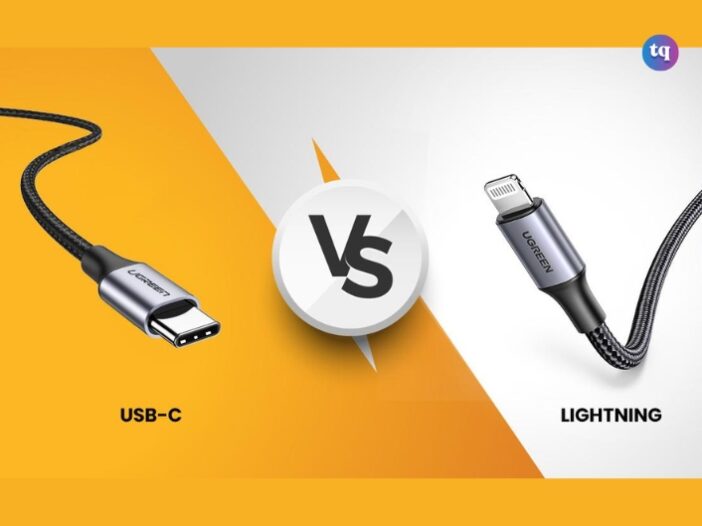
In the world of technology, the type of charging port on your device can significantly impact your user experience. Two of the most common ports you’ll encounter are Apple’s Lightning port and the increasingly popular USB-C port.
Apple’s recent announcement of using USB-C on their new line of iPhone 15s has stirred a lot of interest and questions among consumers.
In this article, we’ll explore the details and the differences between lightning cables and USB-Cs and which one you should be using.
Table of Contents
What is a Lightning Connector?
The Lightning connector is a proprietary, small, 8-pin (or 16-pin) connector that is reversible and provides data transfer and power to iPhones and other various small electronic devices manufactured by Apple. It was introduced in September 2012 via the iPhone 5, the iPod Touch (5th Gen), and the iPod Nano (7th Gen). The 6.7mm by 1.5mm connection can achieve data-transfer speeds of 480 Mb/second but does not support video output.
What is a USB-C Connector?
A USB-C connector is an industry-standard connector used by various device types and manufacturers. USB-C connectors utilize 24 pins and support charging, data transfer, and video output via a single cable. USB-C can transfer data at speeds up to 10Gbps (nearly 20 times that of the Lightning connector). Most importantly, USB-C ports are more robust and durable than lightning ports, making them more reliable over time. USB-C was introduced in August 2014 and was adopted by the IEC in July 2016, making it slightly more modern than the Lightning cable.
READ ALSO: 15 Best USB Headsets to Use in 2024
Lightning Cable vs USB-C: What’s the Difference?
Here are some major differences between a lightening cable and a USB-C
Data Transfer Speeds
USB-C: USB-C supports faster data transfer speeds than Lightning. The latest USB-C technology, such as USB 3.1 and USB 4, can offer data rates of up to 40Gbps, making it ideal for transferring large files quickly.
Lightning: Lightning connectors, while efficient, can’t match the data transfer speeds of USB-C. They typically support USB 2.0 or USB 3.0 speeds, which are slower in comparison.
Charging Speed and Power Delivery
USB-C: USB-C also supports a feature called Power Delivery (PD), which allows for faster charging of devices. With PD, you can charge your smartphone, laptop, or other USB-C devices more quickly and efficiently. USB-C can also deliver higher power levels for charging laptops and other high-power devices.
Lightning: While Apple’s Lightning connector supports fast charging, it doesn’t offer the same level of power delivery as USB-C. It’s mainly designed for Apple’s mobile devices and accessories.
Reversibility
USB-C: One of the most significant advantages of USB-C is its reversible design. You can plug it in either way, saving you the hassle of trying to figure out the correct orientation. This feature makes it more user-friendly.
Lightning: The Lightning connector is also reversible, so it’s relatively easy to connect your Apple devices. However, it doesn’t have the universal compatibility that USB-C offers.
Availability and Accessories
USB-C: USB-C cables and accessories are widely available from various manufacturers and at different price points. This ensures that you have a wide range of options when it comes to choosing accessories or replacement cables.
Lightning: While Apple’s Lightning cables and accessories are readily available, they often come with a premium price tag. Third-party Lightning accessories are also available, but if they are not MFi-certified, they may not meet Apple’s strict quality standards.
USB-C: More Sustainable and Powerful
Ultimately, the mandate from the European Union strives to reduce unnecessary duplicity between proprietary and industry-standard data connectors.
While Apple has historically argued that banning the Lightning cable will increase e-waste, it is feasible that the standardization to USB-C for all small electronics will ultimately reduce the number of new chargers and cables produced.
Conclusion
In conclusion, both Lightning cable and USB-C have their unique advantages and applications. Lightning is well-suited for old Apple users who value a reliable and robust connection within the Apple ecosystem.
USB-C, on the other hand, offers greater versatility, faster data transfer, and higher power delivery, making it a more future-proof and widely adopted standard. Ultimately, the choice between Lightning and USB-C will depend on your specific needs and the devices you use.
FAQs on Lightning Cable vs USB-C
A USB-C to Lightning cable has a Lightning connector on one end, with a USB-C connector on the other end instead of a standard USB-A connector. With a USB-C to Lightning cable, you can charge and sync your iOS devices.
Yes, Apple has replaced the Lightning port with USB-C, starting with the iPhone 15 series.
USB-C supports higher charging power than Lightning, thanks to the open USB Power Delivery (USB-PD) standard. In practical terms, USB-C can deliver as much as 240W of charging power, while Lightning currently tops out at 25W.
The cable takes a lot of stress over time, and that’s a likely culprit when your charger stops working. It’s possible for a charging cable’s copper wiring to be damaged, causing the charger to stop working or work intermittently. Sometimes, however, the charger is the problem, not the cable. To fix a broken charger, test the wall socket and look for damage to the device’s power port.